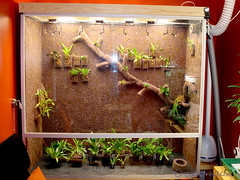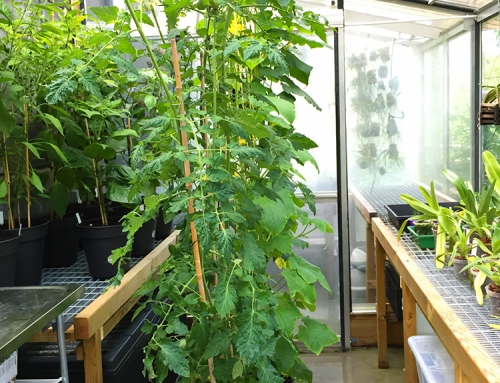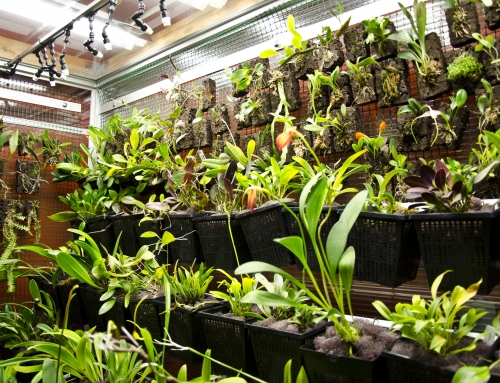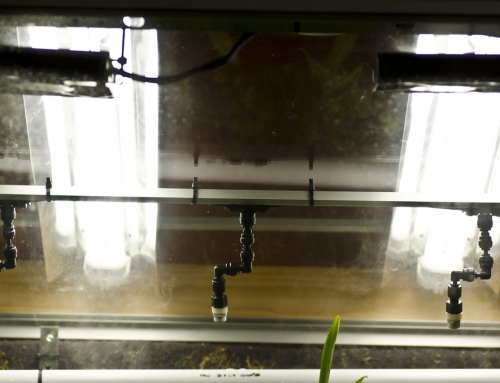Alright… the past few weeks have been very eventful in the orchid department, but I have also been extremely busy at work and I have not had time to write about everything that has been going on, mainly the cool vivarium build… but here we go.
Last time I checked in I had just installed the Vivaria rain system. I have since moved it twice…he he. Well, originally I had placed three nozzles along the top and three nozzles along the bottom at the very front. The nozzles has an 80 degree cone shaped spray, but I found that the reach probably is no more than 40 cm distance. Placing my nozzles at the front of my 65 cm deep viv. meant that the nozzles fell short of the objective of watering the back wall – as well as the orchids of course. I also found that a lot of the fine mist fall so there really was no need for the lower set of nozzles. So, I bought a thin aluminum u-beam and attached the original six nozzles, plus the two extra ones I had gotten, 30 cm from the back wall attaching the eight nozzles about 18 cm apart. I connected the last nozzle in line with an L-bracket to close the system. The pump draws its water from a 25 liter jug. This new configuration worked like a charm for the orchids, but still did not quite do the job watering the moss growing on the back wall… If I run the rain system enough to keep the back wall hydrated, the orchids will get too much. Damn! So I placed an order for a drip watering system to keep the moss happy and leave the rain system to water the orchids – but more on that later.
As soon as I got the rain system up and running I planted three 50g bags of tropical moss mix on the EpiWeb walls. The mix consists of finely ground and dried sphagnum moss as well as 3-5 different kinds of tropical moss. The ground sphagnum moss give the moss seed a better base to establish on. You just mix it with water to a smooth mixture and spread it over the EpiWeb with wet paint brush. I found that the mix should be pretty liquid to spread on nicely. I had to add water many times to keep the mixture good. It is also good to let the mix soak for several hours before you start. I gave the mix about 2 hours and it worked fine. I spread the mix pretty thin, because it is a bit expensive, but also all I need to to give the moss a head start and it will soon grow and spread to cover the whole wall anyway. In the warm vivarium for example, I have not sown any moss, but all the mounts in there are covered in self seeded moss. It will happen here to. Two weeks after the sowing, a few green sprouts have begun to show. Nice!
During all this building, I received a large shipment of orchids from Peru – all of which needed to go into this new vivarium. It was a bit of a mad scramble to get them all situated and comfy while I finished the build. There were a few sleepless nights, but it worked out. My new babies from Peru Flora this time was: Dracula deniseana, Dracula rezekiana, Lepanthes caprimulgus, Masdevallia caloptera, Masdevallia chaparensis, Masdevallia elegans, Masdevallia harlequina, Masdevallia notosibirica, Masdevallia parvula, Masdevallia whiteana, Maxillaria picta, Ornithocephalus gladiatus, Pleurothallis nuda, Porroglossum peruvianum, Restrepia elegans, Scaphosepalum dalstroemii, Telipogon campoverdei and a Trichosalpinx zephyrina. A real treasure in other words!! Especially the Masdevallia harlequina, the first Masdevallia I fell in love with (in a photo) years ago, I am stoked to finally have this in my collection. All newcomers are now thriving – yeah, they really are, even the Telepogin – in the new viv. I am picking up another large order (mostly Dracula) from Ecuador at the Sofiero orchid show in the south of Sweden for my birthday in a couple of weeks, I can barely wait!
One more thing… Since I want to be able to move my plants once established, I do not want to mount them directly on the EpiWeb walls. I want to be flexible if I need to photograph them or divide them for example. So I cut small mounts for all the plants from the remnants from the large EpiWeb panels I used for the back walls. I mounted the smaller orchids to the EpiWeb blocks, and some to the EpiWeb branches, and planted the larger ones in square plastic mesh pots (the same used for aqatic plants) with EpiWeb substrate. I will keep the pots on the bottom of the viv. it will be nice and green down there, almost like a lawn. The cool thing about EpiWeb is that it does not whick water, but it holds about 70% of its weight in water. So it is next to impossible to overwater plants in this material. A good thing in a wet environment like this. I do the same for the pots in the warm viv.
Since the moss requires more water than the orchids I had to install a separate watering system for it… The EpiWeb ILS drip watering system is a pretty simple concept really. A PVC pipe with tiny holes drilled into it, water is pushed up through the pipes with a pump normally used for fountains. I cut the pipes to length, connected them with L-brackets and just zip tied them to the EpiWeb wall. Naturally the aluminum beam for the rain system nozzles were in the way for the pipes, so I had to move them a third time… but hey that ‘s life. This system uses a lot of water so it requires a closed system, so I got a second 25 liter water jug for this purpose. I did not want to use the same water as I use for the rain system since the return water will include some debris and I do not want the rain nozzles to clog up from this. The pump need to be submerged so it is placed inside the jug and the drain drains right back into the same jug. I have a funnel temporarily guiding the water right now, but I will get the proper tubing connected to my drain later. With the runoff from the rain system it should even out from the water retained/consumed but this is a balance I have to monitor over the next few months. Good thing we gave up on the guest room idea a long time ago… the pumps for these two systems are not exactly whisper quiet… but the drip system runs for about 15 minutes 3 times a day and the rain system (which is the loudest) runs for 1 minute about 3 times per day, so it is ok.
The goal is to mimic the conditions of the locations where these orchids grow, a cloud forest in the Central/South American mountains, so I will adjust my technology to to just that. Some fine tuning is required, but now I have all the components I need in place. I must say that looking back on this build now that it is basically done, I am very pleased with the outcome!! There are no build kits for these things you can buy. Hell, there are not even any viable documentation on a build this complex, so I hope my blog can at least help fill some of that void. Because it is a marvel of engineering this thing, if I do say so myself. Even dear husband has gotten intrigued with orchids though this build, mainly because of all the engineering involved with building a Peruvian cloud forest in an apartment in Sweden… and that is a bonus I could not have predicted but welcome dearly.
Some videos on the systems at work… Rain, drip and fog running – Drip irrigation – Fog at work. Finally, here is a slideshow of all the photos I took documenting the build.























a marvel of engineering! Can’t wait to see this thing mature. Do you thing your lights are strong enough to reach the orchids at the bottom of the enclosure?
Thanks a lot Tony! How is your moss coming alog? Mine is just starting to germinate now 2+ weeks after sowing. Yes I do think the lights are strong enough. None of the plants down there demand a lot of light (Masdevallias mainly) and the manufacturer of the Dulux 80W lights claim they reach 150 cm at specified intensity. So I really think it will be alright.
The moss is making a slow comeback after the trip. It’s been in the orchidarium for a week now. I transported it in giant petri dishes with lids.
Good to hear Tony! It will take some time, but if it survived the move I think it will eventually restablish.
‘m green of envy !!! that thing that spreads fog is very cool, Id like to put 100 all around my place !
Thanks!! 😀 😀
Yeah, the fogger is really cool! It holds 5 liters of water too so it lasts a few days which is nice.
Hello Karma,
I really love your web and your photos on flickr. I can’t stop wondering where I could buy some of that ‘moss mix’ you applied on the walls. Do you know any europen dealer I could get some from? By the way, I’m from Spain.
Thanks,
Andrés
Hi Andrés! I am very happy to hear that you enjoy my blog and photos. 🙂 I bought my tropical moss mix from a Swedish company called Dusk. Email and ask them if they can send to you in Spain. Here is a link to their website, and their email address. However, they sometimes can take a long time to reply to mail though… just so you know. http://www.dusk.se dusk@dusk.se I also think that the UK company Dartfrog sells a similar moss mix, if not the same. I am pretty sure they can send to Spain since I have ordered from them to Sweden. Here is their website: http://www.dartfrog.co.uk If you can’t get a hold of it let me now and I will see if I can help. Good luck!!
Thanks a lot Karma, you’ve been really helpful! I have just ordered some from Dartfrog, we’ll see.
Keep us updated on how your orchids and moss are going! Good luck!
Good to hear!! All the stuff I have ordered from Dartfrog has been good, even though I have not tried their moss mix. Let me know how it goes. 🙂 My moss is coming in strong now, it is really nice! …but in patches as I was a little too cheap with the moss… should have spread more of it out to get a bit more even coverage. Oh well, it will fill in eventually.
You could also try ‘Vesicularia dubyana’ for moss coverage. It’s cheaper and grows like crazy under bright light and high humidity. I tried once and it didn’t take more than one month to spread all over my terrarium. Nevertheless, the moss mix seems more intereting, as it has real southamerican tropical mosses and some fern spores.
Ah Java Moss. Used to have it in an aquarium with fish years ago… not sure I want that all over my vivarium though. The tropical moss is a little bit more interesting and it will spread given enough time. 🙂
Hi! Can you tell me how often do you turn the fog system on? (how many times and for how long every day?) I also have a vivarium (much more humble than yours) and I have the opinion that the fog system makes all the difference as a complement to the rain system. I used to have trouble keeping the humidity stabilized (and I still do sometimes) but I try not to use too much the rain system because when I do, I think some leaves begin wrinkling. Your system also has the advantage of having a water flow through the walls which is something I can’t promote in mine. Hope I made myself clear and not many mistakes..!
Hi Dave, you make yourself perfectly clear. Running the rain system to keep RH up might be difficult as I think it will get a bit too wet in there, perhaps if you just run it for a couple of seconds at a time? But I think you will be better off with a fogger like you say. I used to control the fog with an interval timer, but I found it was too hard to “guess” when to turn it on/off to keep a stable RH. So instead of running the fog on a manual timer I now have it connected to a humidistat instead. It will automatically turn the fogger on when the sensor detects RH dropping below 80% so now I do not have to worry about it, money well spent. I got the Lucky Reptile Humidity Control II and I really like it. It is super easy to set, has two circuits (day and night). I have the thermostat from the same brand also. I wrote more about it in this post: Cool vivarium – some fine tuning and upgrades. Good luck with your vivarium!
Well thats really advanced stuff! Allways learning! Maybe someday I’ll have the time to dedicate myself more to this hobby and improve my vivarium. Next month I’ll be travelling to study abroad so I try to leave this as automated as possible and, at the same time, to keep it simple, so that someone who has to take care of it won’t get crazy with too many butons. =) Thank you.
Well, perhaps my build is a bit advanced… but if you want peace of mind being gone for a while I recommend as much atomization as possible. 🙂 Good luck with your viv. and your studies too.
Thanks , I have just been looking for info about this topic for a
long time and yours is the greatest I have came upon till now.
However, what about the bottom line? Are you sure
in regards to the supply?
Thanks, I’m glad you found my build documentation helpful. 🙂 About the bottom line. Yes, pretty sure. Not counting all the re-do’s at least.